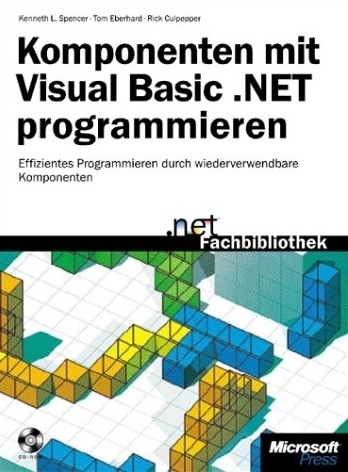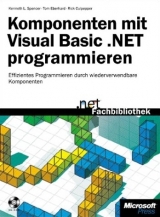Komponenten mit Visual Basic .NET programmieren
Microsoft (Hersteller)
978-3-86063-643-5 (ISBN)
- Titel ist leider vergriffen;
keine Neuauflage - Artikel merken
Microsoft Visual Basic .NET eröffnet Visual Basic-Programmierern durch seine komplette Objektorientierung völlig neue Möglichkeiten der Programmierung. Dieses Buch beschreibt, wie Sie durch konsequent objektorientierte und komponentenbasierte Entwicklung dieses neue Potential ausnützen können.
Am Beispiel einer mehrschichtigen Anwendung werden kurz die wichtigsten Prinzipien der objektorientierten Entwicklung dargestellt, bevor auf die richtige Anwendungsarchitektur und gutes Design von .NET-Anwendungen und natürlich auf die Programmierung von wieder verwendbaren Komponenten, Klassen und Steuerelementen für die verschiedenen Anwendungsschichten eingegangen wird. Am Ende des Buches steht das Zusammenstellen der Anwendung aus den in den vorherigen Kapiteln beschriebenen Komponenten, um neben den für jede Schicht wichtigen Komponenten auch die großen Zusammenhänge nicht aus dem Auge zu verlieren.
Lesen Sie:
-
- Einführung in die objektorientierte Entwicklung
- Anwendungsarchitektur unter .NET
- Ausnahmebehandlung im .NET Framework
- Implementieren der Datenzugriffsschicht
- Implementieren der Sicherheitsschicht
- Steuerelemente für Webclients
- Implementieren der Menühandler
- Implementieren der Geschäftslogikschicht
- Implementieren der Fassadenschicht
- Erstellung der Benutzeroberflächenvorlage
- Erstellung von Informationsseiten
- Implementieren der Geschäftsschicht: XML Webdienste
- Kommunikation mit .NET Remoting
- Die Gesamtanwendung zusammenstellen
Auf Begleit-CD:
- Beispielcode aus dem Buch
- .NET Framework Software Development Kit
- .NET Framework Service Pack 2
Über die Autoren:
Ken Spencer ist Autor zahlreicher Bücher, z. B. „Programming Visual InterDev“. 1999 wurde Ken zum Microsoft MSDN Regional Director des Jahres gewählt.
Tom Eberhard ist IT-Leiter von InfoLink Screening Services, Inc. und Präsident von CPU Inc., einer Internet-Beratungsfirma. Er spricht häufig auf Konferenzen und hat diverse große Unternehmensanwendungen entworfen.
John Alexander (MCT, MCSD) ist Berater und seit 5 Jahren ein MSDN Regional Director.
John Alexander is a Microsoft Certified Trainer (MCT) and Microsoft Certified Solution Developer (MCSD), as well as a Microsoft Regional Director. He currently works as a marketing technologist at G.A. Sullivan.
Inhaltsverzeichen (der englischen Originalausgabe)
Table of Contents
Acknowledgments xv
Introduction xvii
1 Introduction to Object-Oriented Development 1
The .NET Framework 2
Visual Studio .NET Support for Components 6
General Language Changes in Visual Basic .NET 8
Data Type Changes 8
Arrays 9
String Handling 10
Structured Exception Handling 12
Components, Classes, and Objects 13
Components and Classes 14
Class and Module Files 16
Instantiating and Using Classes 17
Structures 19
Property Procedures 20
Working with Methods 21
Overloading Properties and Methods 22
Overriding Existing Methods 23
Events 24
Interfaces and Implements 25
Shared Members 26
Namespaces 26
Inheritance 28
Deploying .NET Applications 29
2 Architectural Options with .NET 33
Choosing the Right Architecture 34
Brief History of Software Architecture 35
One-Tier Architecture 35
Two-Tier Architecture 36
Three-Tier Architecture 39
Flexible n-Tier Architecture 43
Solutions Using the .NET Framework 50
User Interfaces 51
Facade Functions 53
Business Layer 53
Data Access Layer 54
Data Layer 54
Analysis and Design 54
3 Exception Handling in the .NET Framework 59
The Exceptional News on .NET 60
What Is Structured Exception Handling? 61
Structured Exception Handling 62
Object-Oriented Exception Handling 62
The Syntax of the Try Statement 63
Defining Exception-Handling Objects 66
Guidelines for Defining Custom Exception Classes 66
Defining a Custom Base Class for Exceptions 68
Event Logging 75
Exception-Handling Objects and Remoting 78
Creating an Application Exception Class Hierarchy 80
4 Implementing the Data Access Layer 83
The Power of ADO.NET 84
Performance 84
Scalability 84
XML Equals Interoperability 85
Ease of Use 85
Components of ADO.NET 85
Connection Object 87
Command Object 88
DataReader Object 91
DataSet Object 93
The ADO.NET Data Access Object 95
Why Have a Data Access Object? 95
What Will the Data Access Object Do? 96
Our Approach to Database Access and Usage 97
Implementing the Data Access Object 97
The Data Access Object as a Component 97
Private Variables and Objects 100
Constructors 100
Properties 101
The First Method: Running an SQL Statement and Returning a DataSet 102
Exception Handling 103
Logging Exceptions 103
What Else? 104
The Complete Code for the runSQLDataSet Method 107
Using the Data Access Object 118
Additional Questions About Data Access 119
How Do We Handle Transactions? 119
What About Data Concurrency? 119
What About Connection Pooling? 119
Can We Use Performance Counters? 120
5 Implementing the Security Layer 121
Overview of Relevant .NET Security Features 122
Application Security Needs 123
Forms Authentication Services 124
Creating the Forms Authentication Architecture for an Application 125
Configuring the Application 126
Creating the Credentials Store 128
Creating the Login Form 129
Authorization Features 134
Authorization Types in the .NET Framework 135
Working with Role-Based Authorization 135
URL Authorization 138
The Security Layer 138
Creating the SecurIt Component 140
Creating the Secure ASP.NET Header 148
Using the SecurIt Layer 153
6 Implementing Generic Web Client Handlers 157
User Interface Options with ASP.NET 158
The Past 158
The Present 159
The Future 161
Choosing Between User Controls and Custom Server Controls 161
Building User Controls 163
The Basics of User Controls 164
Properties of User Controls 167
Methods of User Controls 171
Event Bubbling in User Controls 173
Dynamically Loaded User Controls 175
Building Custom Server Controls 178
The Basics of Full Custom Server Controls 179
Enhanced or Derived Custom Server Controls 185
Enhanced ASP.NET DropDownList Server Control 185
Highlighting the Selected Textbox Server Control 188
Composite Server Controls 192
Composite ASP.NET MyLabelTextBox Server Controls 193
Enhanced Composite ASP.NET MyLabelTextBox Server Controls 201
Events and Custom Server Controls 205
Using Windows Forms Controls 206
7 Implementing the Menu Handlers 211
A Bit of Menu Strategy 212
Our Approach to Designing Effective Menus 214
Creating Menu and Navigation Bar Objects 218
.NET Technology Used 218
Designing the Control 223
The MenuData Component 224
The Main Menu Custom User Control 229
The Navigation Bar Custom User Control 231
Other Options for User Controls 236
A Visual Basic .NET Windows Forms Example 238
8 Implementing the Business Layer 243
Why Do We Need a Business Layer? 243
Designing Generic Business Objects 244
Determining Business Rules 246
Interacting with the Security Layer 247
Interacting with the Data Access Layer 248
Building and Determining Queries Based on Business Rules 248
Get-Related Stored Procedures 255
Insert-Related Stored Procedures 257
Update-Related Stored Procedures 259
Object-Oriented Features of Visual Basic .NET 261
Constructors Revisited 261
Overloading 263
Overloaded Constructors 264
Inheritance in HRnet 265
9 Implementing Facade Layers 271
Advantages of Facade Layers and Applications 272
Designing the Facade Layers 273
Building the Facade Objects 275
The EmployeeHRObject Facade Class 281
EmployeeCSObject Facade Class 283
10 Creating the User Interface Template 287
HRnet Sample Application Specifications 288
HRnet Application Architecture 288
HRnet Application Functionality 289
Creating the HRnet Web Template 294
The Web Template Layout 294
The Web Template Files 295
Starting the HRnet Application 299
The HRnet Home Page 301
Web Page Templates: The Other Option 304
Additional Functionality 310
Creating the HRnet Windows Forms Template 311
The Base Forms 312
The Final Data Entry Form 315
Calling Code from Web Pages and Windows Forms 315
11 Building Information Pages 317
A Bit of User Interface Strategy 318
Web-Based vs. Windows-Based Data Presentation Forms 320
Data Presentation Forms 321
ASP.NET DataGrid Control for List Forms 321
Customizing the Default ASP.NET DataGrid Control 325
Adding Functionality to a Custom DataGrid Control 328
Adding Better Graphics 332
Changing the Footer 333
Adding the GoTo Function 337
Adding Sorting Capabilities 342
Adding Final Enhancements 346
Showing Detail Information 350
A One-Page Grid and Detail Form 351
Grid and Detail Forms Separated 356
Enhancing the Page Grid and Detail Form 359
State Handling in the Detail Custom Server Control 363
Scalability and Performance 367
12 Implementing the Business Layer: XML Web Services 373
Implementing XML Web Services 374
Consuming XML Web Services 376
Under the Proxy’s Hood 378
Using Publicly Available Services 378
The WeatherInfo Web Control 383
SOAP: Your XML Web Service’s New Best Friend 385
Currently Supported Protocols 385
SOAP Document Structure 386
Calling from the Client 389
13 Using Remoting for Communication 391
Starting Out 391
Creating the Server 393
Building Your First Remoting Client 395
Building the Remote Host 400
Windows Hoster 400
Windows Service Hoster 401
Remoting the Business Objects 405
Security Layer 406
Business Layer 407
Remoting Deployment 409
Creating the Client 410
14 Wiring the Application Together 417
Steps for Wiring the Application 418
Step 1: Menu Structure and Templates 419
Step 2: Security 421
Step 3: The Home Page 429
Step 4: Information and Data Pages 437
An HRnet Windows Form: Titles 454
Titles: DataGrid and Detail in One Windows Form 454
Deploying an Application 459
Deploy with XCOPY 460
Deploy Global Files 460
Deploy by Creating a Windows Installer Package 463
Assemblies and Versioning 465
INDEX 469
| Reihe/Serie | .net Fachbibliothek |
|---|---|
| Zusatzinfo | 1 CD-ROM |
| Gewicht | 890 g |
| Einbandart | gebunden |
| Themenwelt | Informatik ► Programmiersprachen / -werkzeuge ► NET Programmierung |
| Schlagworte | Visual BASIC .NET • Visual BASIC .NET (VB.net) |
| ISBN-10 | 3-86063-643-X / 386063643X |
| ISBN-13 | 978-3-86063-643-5 / 9783860636435 |
| Zustand | Neuware |
| Informationen gemäß Produktsicherheitsverordnung (GPSR) | |
| Haben Sie eine Frage zum Produkt? |
aus dem Bereich




